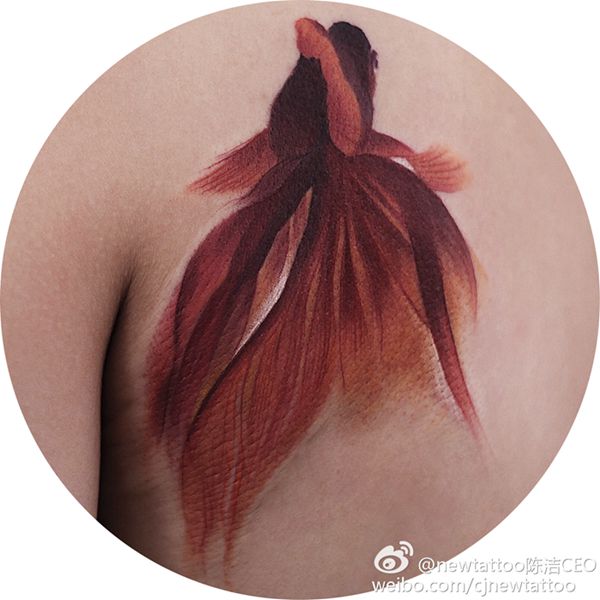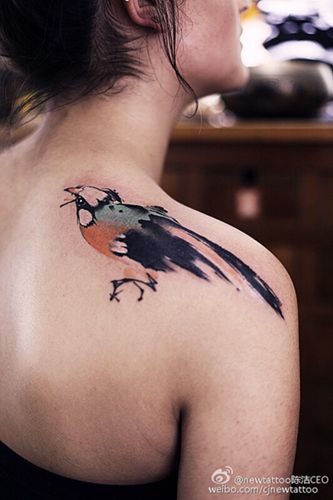It’s not difficult to find a tattoo parlor and get yourself inked in Beijing these days thanks to the rising trend of tattoo fashion and increase of tattooists in the country in the past decade. However, as more and more people around you are wearing tattoos, it has suddenly become more important somehow to find a tattooist who you trust and is able to make a tattoo that is hard to get copied, in particular at a time when people value individualism much more than ever before.

Chen Jie is a Beijing-based tattoo artist who has been holding the tattoo gun for 13 years. She runs a tattoo studio called New Tattoo at the Sunlitun bar street in downtown Beijing, capital of China, where scores of other tattoo parlors stand between bars and restaurants.
Chen’s 60-square-meter studio is not the most eye-catching one in Sanlitun, but she’s now one of the most well-known tattoo artists on the Internet thanks to her unique work.
The most distinguishing feature of her work is to integrate the traditional Chinese ink and wash painting into Western tattoo art, which has won her fame from both Chinese locals and many foreigners interested in Chinese traditional paintings and calligraphy as well as tattoo art.
Among Chen’s customers, while more than half are ladies, there are also doctors, teachers, and even Chinese civil servants who were previously not allowed to get a tattoo.
Now she has more than 190,000 fans on Instagram, a photo-sharing platform which is blocked in China, and over 50,000 on Sina Weibo, a Twitter-like micro-blogging platform in China.
Before Chen, it was hard to find a tattoo which combined Chinese traditional ink and wash painting with the Western tattoo art. Even until recent years, the most well-known tattoo styles in China were those originating from Europe and America, as well as Japan’s bold and well-developed style, Chen said.
“I think what can really represent China is the traditional Chinese ink and wash painting,” she said.
 Thanks in part to the Internet, Chen’s tattoo work also captured the attention of the media. She said the media tend to regard her as a “great artist”, but she never thought herself as an artist in this field, despite the fame and respect she has won.
Thanks in part to the Internet, Chen’s tattoo work also captured the attention of the media. She said the media tend to regard her as a “great artist”, but she never thought herself as an artist in this field, despite the fame and respect she has won.
“I don’t know too much about cultural things, and I don’t think I’m an artist,” said Chen in an interview with sino-us.com in her studio. “I just want to make beautiful tattoos and be responsible for every tiny inch of my customer’s skin.”
Random inspiration
Born in 1979, Chen began to learn tattoo at the age of 25 from a friend from whom she had gotten her first tattoo in life. However, she didn’t come up with the idea to combine Chinese traditional ink and wash painting with tattoo art at the beginning.
“At the beginning, I nearly drew everything. But gradually, I got confused which way should I go,” she said.
It was not until one night a few years ago when Chen and her husband were staring blankly at home when the inspiration came.
“We didn’t know what to do at that time as the tattoo business we were doing was not enough to help us make ends meet,” she recalled. “Suddenly, I noticed a peach ink and wash painting hanging on the wall in our room. Then I thought maybe it could be really cool if it’s turned into a tattoo on the skin.”
With such an idea, Chen began to pay more attention to traditional Chinese paintings.
Chen’s tattoo works includes many elements from Chinese traditional paintings such as mountains, flowers, birds, monkeys and Dharma. These are also elements depicted by Chinese painting masters like Zhang Daqian, Huang Yongyu, Zhou Chuan’an as well as Liu Jiyou.
However, instead of studying how to draw those paintings, she spent more time on thinking about which part of the painting is more suited to the skin and how to incorporate that part into a tattoo.
Unlike traditional Western style tattoos, the most important feature of Chinese ink and wash style tattoo is that there are few boundaries, according to Chen.
“It’s just like Chinese traditional ink and wash painting. You have to know how to keep the colors on the skin on one hand, and to create a blurred effect on the other,” she said. “And the lighter the colors are, the more difficult it is to express the meaning of the tattoo.”
Aestheticism
Beyond traditional Chinese ink and wash paintings, there are many other themes in Chen’s tattoo art, such as Labrador, butterflies, cartoons, as well as some abstract pictures, the meaning of which you may find hard to capture.
“You don’t have to think too much about what the tattoo means sometimes. As long as you think it’s beautiful, you can just have it,” she said.
However, Chen does not draw all types of tattoos requested by the customers. There are three principles that she always keeps in mind.
“First, I never draw a tattoo that I think is low and vulgar. Second, I never draw a tattoo which another tattooist has drawn before. Third, I never draw the same tattoo that I myself have drawn before, even when it’s the same subject, it should be different from the previous one,” she said.

Now a professional tattooist, Chen said the most important thing for a tattooist is to be responsible for the customers who may keep the tattoo on their body forever. Following that is confidence. “It’s important to show your confidence to your customers who may constantly question the details of your work.”
Although Chen has been working in this field for 13 years, she still feels she cannot be labeled as an artist. For Chen, what distinguishes a tattooist and an artist is not her or his skills, but her thoughts and innovations.
“While skills of good tattooists are all the same in the end, what truly makes a tattooist artist is her thoughts and innovation,” she said. “There is no end in tattooing, you need to absorb great ideas all along your life.”
(Photos courtesy of Chen Jie)
| Touched | Sympathetic | Bored | Angry | Amused | Sad | Happy | No comment |